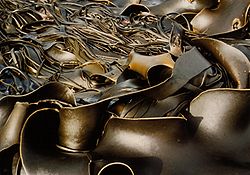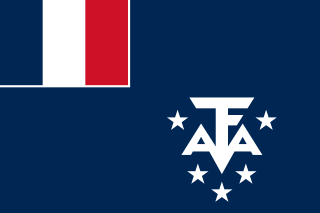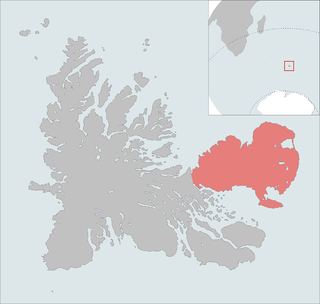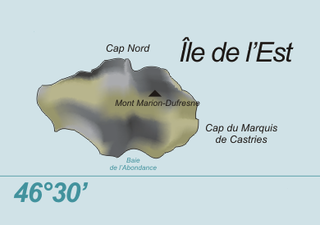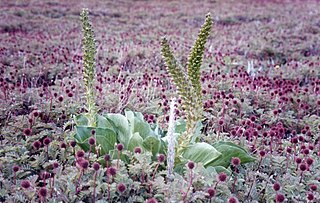Fauna
Mammals
Seals and fur seals:
- Southern elephant seal (Mirounga leonina)
- Antarctic fur seal (Arctophoca gazella)
- Leopard seal (Hydrurga leptonyx) occasional
- Commerson's dolphin (Cephalorhynchus commersonii)
- Type D or Sub-Antarctic orca (Orcinus orca). [3]
- Humpback whale (Megaptera novaeangliae)
- Southern right whale (Eubalaena australis), etc.
Introduced land mammals:
- Bizet sheep. Approximately 3,500 semi-wild sheep live on Ile Longue; their main purpose is to provide meat for the scientific personnel stationed on the islands. Oddly, the Kerguelen flock of sheep, which are known as Bizet sheep, are an endangered breed in continental France from where they originated. The sheep suffer a high mortality rate at birth (~25%), because they have not been able to adjust their reproductive cycle to coincide with the seasons of the southern hemisphere[ citation needed ], resulting in mothers giving birth during the southern winters when food is less abundant. By 2014 there were 150 male Bizet with no females. [4]
- Mouflons (mountain sheep). Numbering approximately 100 or so individuals, they originated from the island of Corsica, and were introduced in 1959. The Kerguelen population was restricted to Haute Island in the Golfe du Morbihan. As part of ongoing efforts to remove introduced species, the population was eradicated by 2012. [5]
- Reindeer. Reindeer were introduced to Ile des Rennes (Reindeer Island), also called Ile Australia, by the Norwegians. Reindeer are excellent swimmers and they soon found their way to the main island of La Grande Terre a short distance away. Today the reindeer of the Kerguelen islands number around 4,000 individuals. They have been able to survive due to their ability to extract sufficient nutrients from the islands' supply of lichens and mosses; however, their presence has had a negative impact on the flora of the archipelago. They form the only such population in the southern hemisphere, apart from a similarly introduced reindeer population on South Georgia which was almost eradicated in 2013, the last two being killed in 2017.
- Rabbits. These small lagomorphs were brought in from South Africa in 1874. They were reintroduced on a second occasion later. The rationale was to provide a fresh food source to sailors who might become shipwrecked. Rabbits have devastated the islands' plant communities, and have caused serious erosion in places where their numbers have exploded - mostly the eastern half of the islands, where population densities have reached 40+ per acre in some places. To date, the western and northwestern limits of the islands have been spared due to a less hospitable climate. The off-lying islands surrounding the archipelago have also been spared. Rabbits were introduced to Ile Verte, but were eradicated by 1992. [6]
- Rats and mice. These were introduced to the islands by ships which were hunting seals and whales. [7]
- Cats. The islands are home to a population of feral cats descended from ships' cats kept by sailors to control the rat population. The cats live mainly on mice, rabbits and albatross chicks. [8] A later cat introduction was made in 1956. [7] [8]
- Dogs. These were also introduced to the islands by ships which were hunting seals and whales; [7] there were some feral dogs reported on the islands between 1852 and 1951, but none have been seen since.
- Equines. Mules were introduced to Port-aux-Français in 1948 and lived there for five years; [7] there were also reports of Shetland ponies living there in the 1950s.
Birds

Penguins:
- King penguin (Aptenodytes patagonicus)
- Gentoo penguin (Pygoscelis papua)
- Southern rockhopper penguin (Eudyptes chrysocome)
- Macaroni penguin (Eudyptes chrysolophus)
Seabirds:
- Albatross
- Black-faced sheathbill [9]
- Cormorants
- Kerguelen petrel
- Kerguelen shag
- Seagulls
- Prions
- Skuas
- Kerguelen tern
The Kerguelen Islands are covered by France's ratification of the International Agreement on the Conservation of Albatrosses and Petrels, drawn up under the auspices of the Convention on Migratory Species.
- Eaton's pintail (Anas eatoni)
- Mallard (Anas platyrhynchos) introduced
Fish
In the 1950s and 1960s, Edgar Albert de la Rue, a French geologist began the introduction of several species of salmonids. Of the seven species introduced, only brook trout Salvelinus fontinalis and brown trout Salmo trutta survived to establish wild populations. [10] Brook trout occupy head water streams, while brown trout have established both resident stream and robust anadromous populations throughout the islands.
Insects
A few species of insects inhabit these islands, some examples are the:
- Calycopteryx mosleyi , a fly closely associated with the Kerguelen cabbage. [11]
- Meropathus chuni, a very small aquatic beetle. [12]
- Anatalanta
- Palirhoeus eatoni
As well as some introduced species like the:
- Oopterus soledadinus, a large ground beetle. [13]
- Merizodus soledadinus, a flightless beetle. [14]

